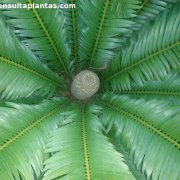Care of the cycad Encephalartos lebomboensis or Lebombo cycad |
|
The genus Encephalartos, family Zamiaceae, comprises 60 species of cycads native to Africa. Some species are: Encephalartos lebomboensis, Encephalartos horridus, Encephalartos ferox, Encephalartos altensteinii, Encephalartos senticosus, Encephalartos natalensis, Encephalartos villosus, Encephalartos lehmannii, Encephalartos transvenosus, Encephalartos aemulans, Encephalartos paucidentatus. Common name: Lebombo cycad. This species is native to the Lebombo Mountains, South Africa. They are fast-growing dioecious plants that reach 4 meters (13.12 feet) in height and produce numerous shoots at the base. The follicles of the long leaves are glossy dark green. The male cones are cylindrical and the female ones are ovoid; both are yellowish-orange in color. Lebombo cycad is used to form small groups of 2-3 plants, as isolated specimens and in pots for patios and terraces. Encephalartos lebomboensis can be grown in full sun or semi-shade exposures. It resists frost down to -3 ºC (26.6 ºF). The soil should be very well drained and contain compost or leaf mulch. The pot transplant is done at the beginning of spring if the roots appear below the pot. Water moderately throughout the year waiting for the substrate to dry. In summer increase watering (especially if it's very hot) to 2 times a week. Encephalartos lebomboensis does not need pruning. Lebombo cycad is a plant resistant to pests and diseases but not to excess watering. Encephalartos lebomboensis propagates from the suckers that the plant produces at its base or by seeds that take several months to germinate. |
Images of the cycad Encephalartos lebomboensis or Lebombo cycad |
Find plants
Encephalartos lebomboensis or Lebombo cycad | Care and Growing
© 2025 FavThemes



